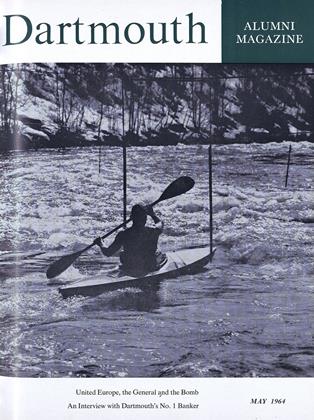A Poetic Chain Reaction
TO THE EDITOR
In the latest edition of your magazine I received so much pleasure from reading Mr. Fowler's poem, "The Ledyard Bridge (1859-1934)," that I was moved to compose the enclosed effort.
My purpose in writing you is not to submit this poem for publication although you may do so if it suits your need, but rather to ask you to forward a copy of it to Mr. Fowler, whom I do not know how to contact directly. Please convey to him my delight with his poem.
I saw that bridge, in thirty-four, (A thawing mid-March night) Stand firm but faint upon its piles, Endure each ice-flow's bite; And like Horatio's hero - mold, Beaten, bent, and steeped in blood, I saw the Ledyard arch go down Into the darkened flood.
So with it passed another age Of carriages and peace, And in its stead now stands our steel Whose restlessness won't cease Until it too shall pass away, As all that-went before; Each age shall have its fading dreams, Lamented, yet adored.
Montclair, N. J.
Sailing "First" Retracted
TO THE EDITOR:
Due to delay in getting mail to this part of the world (Thailand), I am just now receiving the February ALUMNI MAGAZINE.
I noted an error in the column praising the sailing team for its victory in the Sugar Bowl Regatta over the holidays. This is not the first Dartmouth sailing team to represent us in the Sugar Bowl.
A team with Dave Porter '59 represented Dartmouth, I believe, in the 1959 Regatta, and although they didn't win, they made a good showing and enjoyed the New Orleans atmosphere.
1st Lieut., USAF
Change in Massachusetts
TO THE EDITOR:
The article on the Community College which appeared in your last issue was appealing in the logic of its basic idea and its very competent and graceful presentation.
Your readers may find an interesting connotation, as I did, in the following quotation from New France and New England (p. 218) by the eminent historian John Fiske.
"The beginning of the Eighteenth Century in Connecticut was memorable for the founding of Yale College. The journey from the Connecticut towns to Cambridge was much longer than it is now and it was felt that there ought to be a college nearer home. The movement was begun by a meeting at Branford of ten ministers, nine of whom were graduates of Harvard. These gentlemen contributed from their libraries about forty gigantic folios for the founding of a college library. Other gifts began to come in, and an act of incorporation in 1701 created a body of trustees, all of whom were to be clergymen and not less than forty years of age. The college was first settled at Killingworth, where the first rector of the college, Abraham Pierson, was pastor. At length the college was settled in New Haven in 1716 and two years later it received the name of Yale College in recognition of a donation from Elihu Yale, a merchant of London, whose father had been one of the original settlers of New Haven. Now this founding of Yale College exerted a conservative effect upon the mind of Connecticut. While on the one hand it brought a classical education within the reach of many persons who would not have gone to Cambridge to get it, on the other hand it tended to cut off the clergy of Connecticut from the liberalizing influences which were so plainly beginning to be powerful at Harvard. From the outset something like segregation began. Many persons in Massachusetts who were disinclined to the liberalism of Leverett and the Brattles transferred their affections to Yale College, making gifts to it and sending their sons there, and in their way the conservatism of the university that was con- trolled entirely by ministers holding under the Saybrook Platform was increased. When to all these circumstances we add that the royal governor in Boston, although an abiding cause of irritation, nevertheless kept bringing in ideas and fashions from Europe, we can see how the stormier life of Massa-chusetts Bay was more favorable to change than the delicious quiet of the land of steady habits."
Montclair, N. J.
A Cheer for the Team
TO THE EDITOR:
Congratulations to our gallant "Alumni Fun" team: Tom Curtis, Bob Ryan, and Pat Weaver. Not only did they do a grand job, but they seemed to be having real fun in the doing of it.
To me, the final contest with Wisconsin was a bit reminiscent of the famous fifthdown game with Cornell. The fact that our boys seemed to get the hard questions was a matter of the turn of the wheel. I wonder, however, if the affable Mr. Fadiman realized that he both opened and closed the 100-point questions with Wisconsin.
Philadelphia, Pa.
 View Full Issue
View Full Issue
More From This Issue
-
 Feature
FeatureUNITED EUROPE, THE GENERAL AND THE BOMB
May 1964 By HENRY W. EHRMANN, -
 Feature
FeatureDARTMOUTH'S NO. 1 BANKER
May 1964 By DERO A. SAUNDERS '35, -
 Feature
FeatureA New Strategy of Liberal Learning
May 1964 -
 Article
ArticleTHE UNDERGRADUATE CHAIR
May 1964 By DAVE BOLDT '63 -
 Class Notes
Class Notes1936
May 1964 By BARRY C. SULLIVAN, GILBERT BALKAM -
 Class Notes
Class Notes1922
May 1964 By LEONARD E. MORRISSEY, CARTER H. HOYT
Letters to the Editor
-
 Letters to the Editor
Letters to the EditorLetters to the Editor Ulmus Americana
December 1937 -
 Letters to the Editor
Letters to the EditorLetters
February 1940 -
 Letters to the Editor
Letters to the EditorLETTERS TO THE EDITOR
June 1961 -
 Letters to the Editor
Letters to the EditorLetters to the Editor
June 1981 -
 Letters to the Editor
Letters to the EditorLetters
JANUARY/FEBRUARY 1986 -
 Letters to the Editor
Letters to the EditorDusty Tales and Old Friends
NOVEMBER 1998

